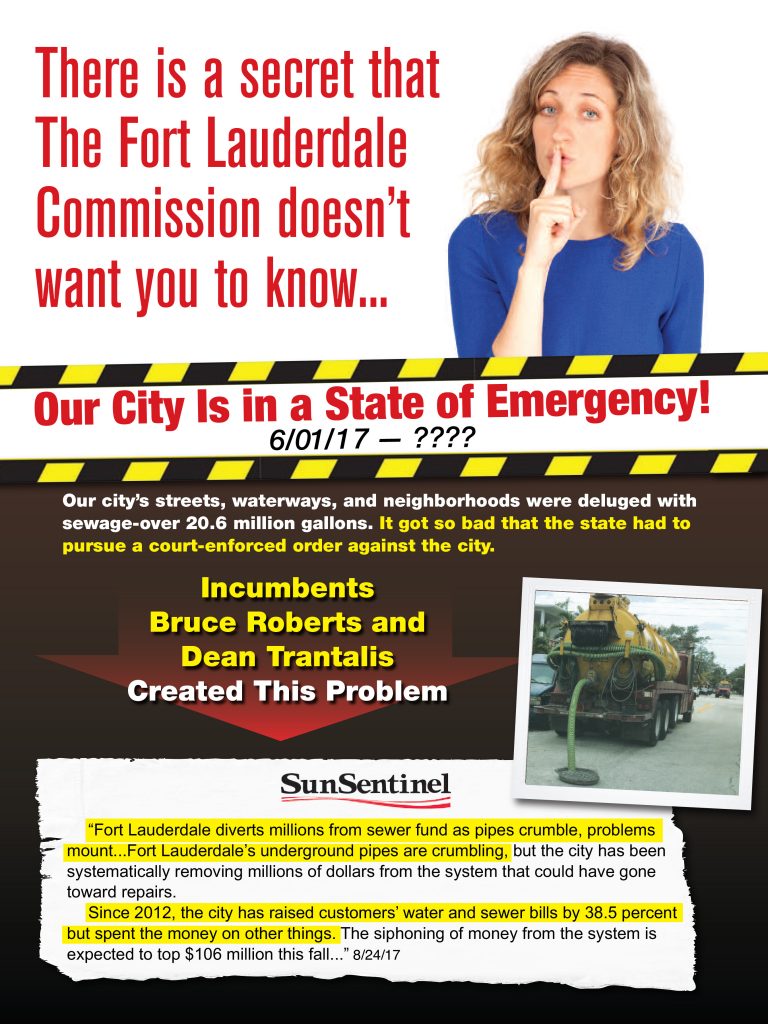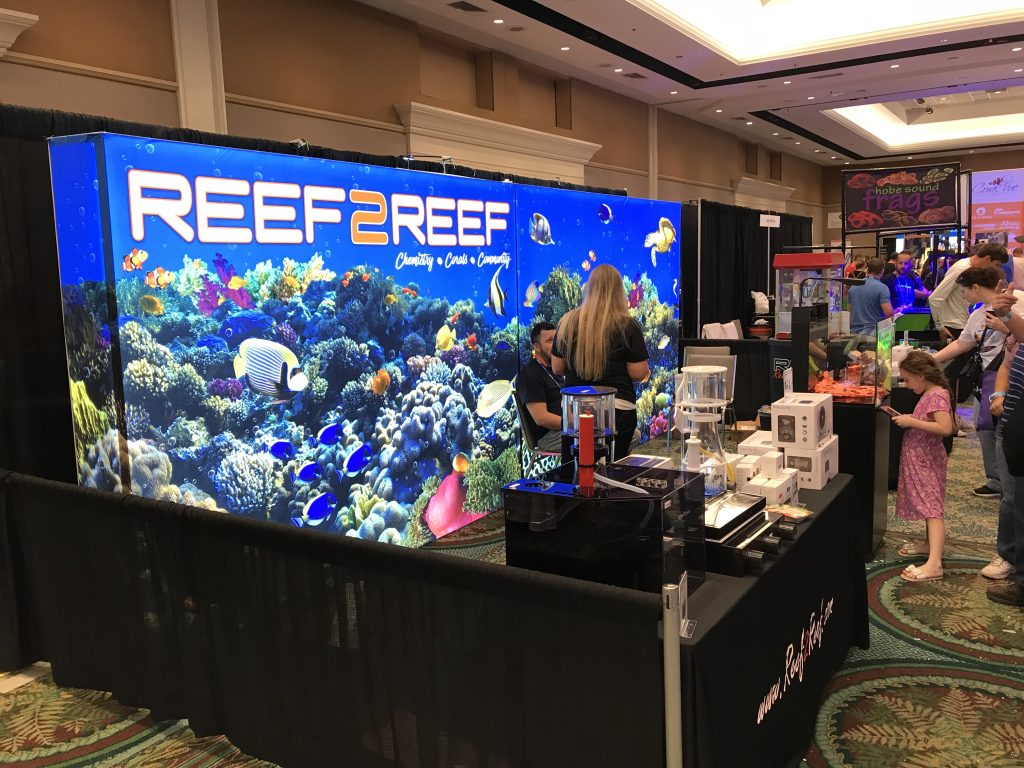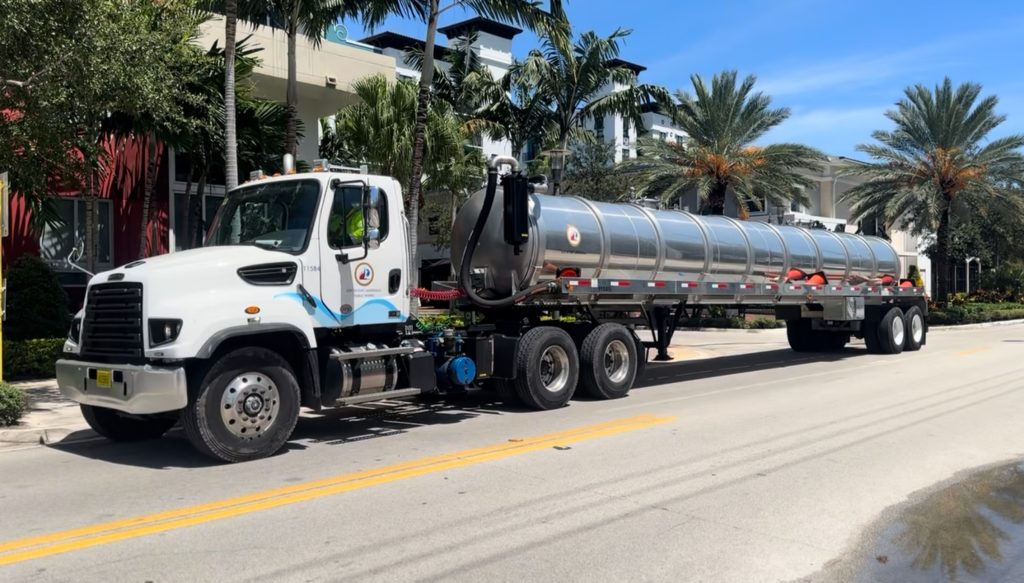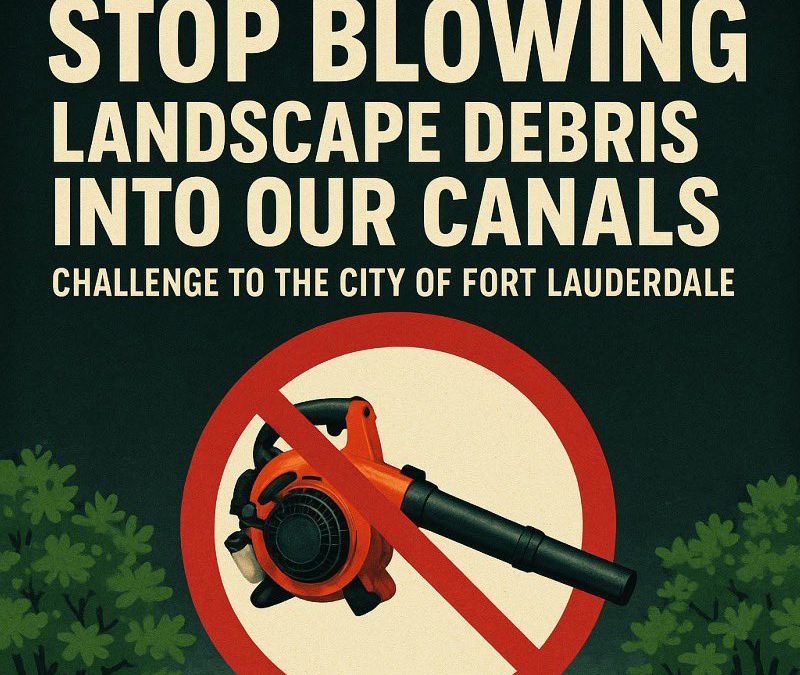I recently saw residents calling on the City to take action on something that might seem small — yard clippings. But it matters.
Fort Lauderdale loves to call itself the “Venice of America.” But if we’re honest, that title is hanging by a thread. Fort Lauderdale’s unique character, shaped by its scenic waterways, marine culture, and status as a world-class boating destination, is slipping away under the weight of political negligence, overdevelopment, and unchecked pollution.
The water is murky. Oxygen levels are crashing. Marine life is disappearing. And instead of urgency from our City Commission, we get talking points and task forces. Meanwhile, canals fill with algae, fish float belly-up, and raw sewage, continues to pour into our waterways after every major rain or infrastructure failure. Actual human waste.
Let’s be clear: this didn’t start yesterday. And it didn’t start with the headlines about 211 million gallons of sewage spewing into the streets and canals between 2019 and 2020.
We’ve been warning about this for years.
A Family Legacy of Advocacy and Frustration
In 2017-2018, my mother, former Commissioner Charlotte Rodstrom, ran a campaign focused almost entirely on controlling overdevelopment and fixing the city’s collapsing infrastructure. She talked about failing pipes, delayed maintenance, sewage backups, how some commissioners supported diverting infrastructure funding for years, and the complete lack of oversight in how this city was managing one if its most essential systems. At the time, many people didn’t want to hear it. It wasn’t flashy. It wasn’t politically convenient, and, unfortunately, it wasn’t a winning election platform.
But she was right.
And we’ve continued talking about it as the issue continued to compound and the problems worsened. It didn’t take a crystal ball to see where this was going. It just took paying attention.

Back then, most people didn’t have their wake-up call yet. That came years later, when the worst spills in city history brought national attention including a state issued environmental protection consent order that forced everyone to confront what we already knew: Fort Lauderdale’s infrastructure and waterways were in crisis.
The volume of sewage water and the damage caused by a single break are enormous. Whether it is 211 million gallons or just one pipe leaking into our storm drains for a few hours or days, the impact is staggering. And that brings us to one of the biggest challenges in this conversation — most people don’t understand volume.
We Don’t Understand Volume
Volume applies to both the pollution being added and the sheer scale of the water we’re trying to clean. Volume is hard for humans to understand. It’s not that we’re unintelligent, it’s that our brains aren’t wired to intuitively grasp massive scale. We can visualize a bucket, maybe a pool. But ask someone to picture a million gallons or billions of gallons? That’s abstract. That’s where it gets lost.
I’ve been keeping saltwater tanks most of my life. For the last eight years, I’ve been the lead moderator of a community of 140,000 people, which includes marine biologists, aquarists, conservationists, and people who really know what it takes to maintain healthy water. I’ve gone to conventions, forums, and lectures around the country for almost two decades. It sounds silly, but check us out on /r/reeftank on Reddit, it’s a community of dedicated salt water fish tank keepers who care about marine husbandry and water quality. We’ve been addressing issues the city is now confronting since the beginning of our hobby. None of the solutions you hear about regarding cleaning up our waterways are new or novel, we’ve been successfully implementing them for decades in my hobby.

In a reef tank, every piece of waste has to be accounted for. You overfeed? The tank crashes. You skip a water change? Algae takes over. You want clean water? Then you need a filtration system — protein skimmers, carbon reactors, mangroves, and other biological or chemical filters — and you need to keep it running constantly. Everything that goes in stays in (in some form or another) unless you actively remove it. There are no shortcuts. Salt water fish tanks are notoriously difficult to keep for those that don’t understand these principles.
In this world, we know something that Fort Lauderdale’s leadership still hasn’t grasped: you can’t ignore the input and expect export to save you.
Now, I have three mangrove trees growing in my living room fish tank. They are all several years old and the average person would have no idea they are even trees. Mangroves grow slowly. Red mangroves can take 5 to 10 years just to reach a few feet in height, and decades to develop the kind of root systems that make a real ecological impact. They are part of a long-term recovery, but they are not a quick fix for active pollution. That said, I believe in their power. They export nutrients naturally, bind sediment, and help stabilize ecosystems. I fully support mangrove planting projects in Fort Lauderdale. I’d love to see Las Olas Blvd, where I grew up, lined with them. Likewise, I think it would be beautiful to reintroduce mangroves to the triangle and am glad we are seeing mangrove planting at George English park.

Featuring: Nine Colorado Sunburst Anemones, three mangrove trees (top)
Water Quality? Failing. Leadership? Also Failing
Independent water quality tests confirm what residents already know. Nitrogen and phosphorus levels are off the charts. Fecal coliform counts are routinely high. Fish kills are no longer shocking, they’re expected.
Between late 2019 and early 2020, over 211 million gallons (equivalent to the Gulf Oil Spill) of raw sewage were dumped into our canals due to broken pipes and failed infrastructure. Outrage followed. Statements were made. Ribbon cuttings ensued falsely claiming the waterways were cleaned up. Promises issued. But on the ground, very little has changed. The pipe’s continue to break and manhole covers still overflow with raw sewage right into our storm drains and into our waterways. A new force main was installed but many of the pipes in our city are still decades old and well beyond their useful life. We don’t even know how old many of the pipes are.

I saw something a few days ago out on the water that should’ve made me happy, three dolphin swimming together in the Intracoastal. I’d never seen that before. I’ve seen dolphins before, sometimes one, maybe two, but never three swimming together, at least not in the Fort Lauderdale Intracoastal. It was beautiful. For a second, I felt lucky. Then it hit me: they were probably lost. The water is too polluted. They didn’t belong there. No more than a goldfish belongs in a gasoline tank. And maybe that’s the most honest reflection of what we’ve done to our waterways; even the wildlife doesn’t know where to go anymore. I hope they made it back to the ocean.
A New Title, a Real Opportunity
The City recently created a position: Chief Waterway Officer. It was a promising move, a recognition that someone needed to be directly accountable for the condition of our canals. The job was given to Marco Aguilera, a longtime City employee with experience in enforcement and municipal operations.
It’s fair to say his appointment caught some in the boating and environmental community off guard. Aguilera doesn’t come from a marine science background, nor does he have direct experience in conservation, sectors that play a major role in Fort Lauderdale’s economy and identity.
That said, this is still an opportunity. Aguilera now has a platform to make meaningful change, and if he takes it seriously, he can earn the trust of a community that’s desperate for action.
Fort Lauderdale’s Water Still Stagnates
Some people try to argue: “Well, a city isn’t a fish tank. It’s open water. Everything gets flushed out daily.” No, that’s not how this works.
Fort Lauderdale may not be a sealed system like a reef tank, but the movement of water in our canals is far slower and more contained than people think. The tides come and go, sure, but there’s limited flow.
Years ago, Buddy Sherman, longtime owner of Southport Raw Bar, once told me, only half-joking (I think), that when he died, he wanted his ashes spread in the water behind the Southport. Because, as he put it, “I know I’ll never go anywhere.”
That comment stuck with me. He was talking about legacy, but unintentionally, he explained exactly why the water never gets better.
The pollution we add stays. It settles into the sediment. It gets stuck. It feeds algae. It suffocates fish. And unless we get serious about stopping the input, nothing we do on the export side will ever be enough.
Not even mangroves. Not even skimmers the size of trucks. Not even hundreds of oysters hanging behind your dock. Not tons of biochar. Not even living sea walls. Not even prayer.
Planting mangroves is fantastic. And I am by no means trying to discourage those pushing export mechanisms. Everything matters and everything has an impact. Projects that restore oysters, deploy biochar, and reintroduce native vegetation all play a role in long-term recovery. But if mangroves are planted next to a pipe leaking fecal water, or downstream from a storm drain packed with lawn chemicals, their impact will be minimal to non-existent. The first step is cutting off the source, stopping the bleeding. I am simply calling on the City to get serious about addressing the root causes of these problems rather than expecting community-led solutions to clean up the City’s mess.

None of it will matter unless we fix the pollution.
That means:
- Fix the damn pipes (we are making progress but it has been painfully slow).
- Stop blowing yard waste and trash into the storm drains.
- Install catch screens.
- Clean the drains regularly.
- Hold contractors and developers accountable for construction run-off.
- Enforce anti-dumping rules.
- Use the money from development to protect what’s left.
This is a scale problem, a leadership problem, and a willpower problem. And it won’t be solved with pretty renderings or greenwashed press releases. It’s going to take work — real, boring, regulatory work — and a commitment to fixing what flows in.
We don’t need a rebranding campaign. We need working infrastructure.
We don’t need buzzwords. We need clean water.
We don’t need another press release. We need pipes that don’t explode under our feet and then pollute into our waterways.
The City has the money. It has the engineers. It has the data. What it lacks is the political will to act.
A Simple First Step & Shared Responsibility
If Fort Lauderdale is going to be this slow to fix its infrastructure, then the least we can do, right now, is stop making things worse.
Let’s start with a basic, common-sense ask: City employees and contractors should stop blowing debris, especially biological waste, into our storm drains. That includes leaves, grass clippings, trash, dog feces, and any other organic matter that becomes nutrient pollution the moment it hits the water.
Blowing yard debris is a serious environmental and infrastructure problem. First, those clippings break down and release excess nutrients into the water, fueling algal blooms and choking marine life. Just as critically, they clog our stormwater infrastructure, block check valves, and slow drainage. Over time, this causes backups that contribute to street flooding and reduce the system’s ability to handle even normal rainfall. And in a city facing rising sea levels and a growing threat of tidal and rain-driven flooding, seemingly small practices like this matter more than ever.
Is this a drop in the bucket? Absolutely. But it is an easy and practical step that can be done with relative ease.
And let’s take it a step further. If you have a landscaper, tell them to rake and bag. If you do your own yard work, put the waste in your green bin, don’t blow it down the street. That debris ends up in the same water you boat in, fish in, live near, and rely on.
This is a simple first step. It shows leadership. And it proves that we actually care about the city we claim to love.
Credit where it’s due: much of this conversation, especially around blowing pollutants into drains, has been amplified by @FixFTL on X (formerly Twitter) and people like Jeff Maggio. Give them a follow. They’re doing the work.
Let’s stop blowing it.


The ‘grass blowing’ issue was brought up in October 2024 at the candidates Waterway Forum at George English Park, where it was pointed out the city contractors were doing that very activity at the Park during landscaping operations. Unfortunately, it’s still going on.
Additionally, many of my friends who are frequently on the water are still complaining about the massive amount of garbage and debris in our waterways. Friends are also saying they don’t see the city’s waterway cleanup boats working.